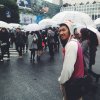Kabuki was once a popular source of entertainment in Dotonburi area. That’s why today, exploring the world of kabuki (either by attending plays that are still regularly held in nearby Shochizuka Theater, or simply by learning its history), will bring one’s knowledge of Osaka culture to a more intimate level. As the place where kabuki was widely enjoyed, Dotonburi now offers another way to get close and personal with kabuki: the Kamigata Ukiyo-e Museum.
Ukiyo-e is an art of multicolored woodblock printing that was first introduced during Tokugawa Period. Most Japanese regions depicted geishas and women in general as the object of the ukiyo-e. However in Osaka, ukiyo-e that is also known as Kamigata ukiyo-e, was mainly centered around kabuki.
The role of ukiyo-e in kabuki business were really important, as kabuki plays used ukiyo-e as their main publication material—similar to today’s movie posters. Ukiyo-e were also portrayed kabuki actors, ensuring a steady demand for these prints from kabuki fans, the forerunner of the practice of collecting celebrity posters. The most popular ukiyo-e from the kabuki era are now housed in Kamigata Ukiyo-e Museum.
Located right in the heart of Dotonburi, the museum offers visitors ease and rich insights about how important ukiyo-e was at old times. Exhibitions of two centuries old delicate printings produced in Osaka are showcased inside two large rooms of the building. The lights in both rooms are dimmed to preserve the original color of the printings, and this makes the colors of each ukiyo-e come out of the woodblock patterns. Visitors can see the beauty of ukiyo-e with the eyes of kabuki idols from back then.
What makes the collections in Kamigata Ukiyo-e Museum unique is that the printings don’t just tell stories about kabuki, but also briefly describe the story line of the plays. I was enraptured by the section that told a story about involving sake during kabuki plays, making the performances of all actors all the more charming and uninhibited, thanks to the alcohol.
Kamigata Ukiyo-e Museum building has four floors: ticket counter and shop on the first floor; exhibitions on second and third floor; and a common area on the fourth floor. The last one was pretty interesting.
This is the area where visitors can learn more about ukiyo-e in general, not just about kabuki. There is a TV at the end of the tatami room, comfortably laid out with cushions and table, where you can sit and watch a documentary of ukiyo-e making process. This room also serves as the place for Kamigata Ukiyo-e Woodblock Printing Experience Course, where for an additional fee, visitors can actually try woodblock printing and make an ukiyo-e pattern on a post card.

































